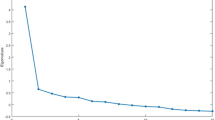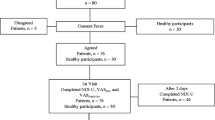Abstract
Purpose
The aim of this study was to translate and cross-culturally adapt the Core Outcome Measures Index for (COMI) into a Simplified Chinese version (COMI-SC) and to evaluate the reliability and validity of COMI-SC in patients with neck pain.
Methods
The COMI-neck was translated into Chinese according to established methods. The COMI-neck questionnaire was then completed by 122 patients with a hospital diagnosis of neck pain. Reliability was assessed by calculating Cronbach’s alpha and intraclass correlation coefficient (ICC). Construct validity was assessed by correlating the COMI-neck with the Neck Pain and Disability Scale (NPDS), the Neck Disability Index (NDI), the VAS and the Short Form (36) Health Survey (SF-36). Using confirmatory factor analysis to validate the structural, convergent and discriminant validity of the questionnaire.
Results
The COMI-neck total scores were well distributed, with no floor or ceiling effects. Internal consistency was excellent (Cronbach’s alpha = 0.861). Moderate to substantial correlations were found between COMI-neck and NPDS (r = 0.420/0.416/0.437, P < 0.001), NDI (r = 0.890, P < 0.001), VAS (r = 0.845, P < 0.001), as well as physical function (r = − 0.989, P < 0.001), physical role (r = − 0.597, P < 0.001), bodily pain (r = − 0. 639, P < 0.001), general health (r = − 0.563, P < 0.001), vitality (r = − 0.702, P < 0.001), social functioning (r = − 0.764, P < 0.001), role emotional (r = − 0.675, P < 0.001) and mental health (r = − 0.507, P < 0.001) subscales of the SF-36. An exploratory factor analysis revealed that the 3-factor loading explained 71.558% of the total variance [Kaiser-Mayer-Olkin (KMO) = 0.780, C2 = 502.82, P < 0.001]. CMIN/DF = 1.813, Tucker–Lewis index (TLI) = 0.966 (> 0.9), Comparative Fit Index (CFI) = 0.982 (> 0.9), Normed Fit Index (NFI) = 0.961 (> 0.9), RMSEA = 0.082 (< 0.5) indicating that the model fits well.
Conclusion
COMI-neck was shown to have acceptable reliability and validity in patients with non-specific chronic neck pain and could be recommended for patients in mainland China.
Level of evidence
Diagnostic: individual cross-sectional studies with consistently applied reference standard and blinding.


Similar content being viewed by others
References
Safiri S, Kolahi A-A, Hoy D et al (2020) Global, regional, and national burden of neck pain in the general population, 1990–2017: systematic analysis of the Global Burden of Disease Study 2017. BMJ. https://doi.org/10.1136/bmj.m791
Hoy D, March L, Woolf A, Blyth F, Brooks P, Smith E, Vos T, Barendregt J, Blore J, Murray C, Burstein R, Buchbinder R (2014) The global burden of neck pain: estimates from the global burden of disease 2010 study. Ann Rheum Dis. 73:1309–1315. https://doi.org/10.1136/annrheumdis-2013-204431
Ferrari R, Russell AS (2003) Regional musculoskeletal conditions: neck pain. Best Pract Res Clin Rheumatol. 17:57–70. https://doi.org/10.1016/s1521-6942(02)00097-9
Côté P, Cassidy DJ, Carroll LJ, Kristman V (2004) The annual incidence and course of neck pain in the general population: a population-based cohort study. Pain 112:267–273. https://doi.org/10.1016/j.pain.2004.09.004
Hoy DG, Protani M, De R, Buchbinder R (2010) The epidemiology of neck pain. Best Pract Res Clin Rheumatol 24:783–92. https://doi.org/10.1016/j.berh.2011.01.019
Bombardier C (2000) Outcome assessments in the evaluation of treatment of spinal disorders: summary and general recommendations. Spine (Phila Pa 1976). 25:3100–3103. https://doi.org/10.1097/00007632-200012150-00003
Jackowski D, Guyatt G (2003) A guide to health measurement. Clin Orthop Relat Res. https://doi.org/10.1097/01.blo.0000079771.06654.13
Guyatt GH, Feeny DH, Patrick DL (1993) Measuring health-related quality of life. Ann Intern Med 118:622–629. https://doi.org/10.7326/0003-4819-118-8-199304150-00009
Freedman KB, Back S, Bernstein J (2001) Sample size and statistical power of randomised, controlled trials in orthopaedics. J Bone Joint Surg Br 83:397–402. https://doi.org/10.1302/0301-620x.83b3.10582
Terwee CB, Bot SD, de Boer MR, van der Windt DA, Knol DL, Dekker J, Bouter LM, de Vet HC (2007) Quality criteria were proposed for measurement properties of health status questionnaires. J Clin Epidemio. 60:34–42. https://doi.org/10.1016/j.jclinepi.2006.03.012
Guillemin F, Bombardier C, Beaton D (1993) Cross-cultural adaptation of health-related quality of life measures: literature review and proposed guidelines. J Clin Epidemiol 46:1417–1432. https://doi.org/10.1016/0895-4356(93)90142-n3
Pynsent PB (2001) Choosing an outcome measure. J Bone Joint Surg Br 83:792–794. https://doi.org/10.1302/0301-620x.83b6
Deyo RA, Battie M, Beurskens AJ, Bombardier C, Croft P, Koes B, Malmivaara A, Roland M, Von Korff M, Waddell G (1998) Outcome measures for low back pain research A proposal for standardized use. Spine (Phila Pa 1976) 23:2003–2013. https://doi.org/10.1097/00007632-199809150-00018
Melloh M, Staub L, Aghayev E, Zweig T, Barz T, Theis JC, Chavanne A, Grob D, Aebi M, Roeder C (2008) The international spine registry SPINE TANGO: status quo and first results. Eur Spine J. 17:1201–129. https://doi.org/10.1007/s00586-008-0665-2
White P, Lewith G, Prescott P (2004) The core outcomes for neck pain: validation of a new outcome measure. Spine (Phila Pa 1976) 29:1923–1930. https://doi.org/10.1097/01.brs.0000137066.50291.da
Fankhauser CD, Mutter U, Aghayev E, Mannion AF (2012) Validity and responsiveness of the Core Outcome Measures Index (COMI) for the neck. Eur Spine J 21:101–114. https://doi.org/10.1007/s00586-011-1921-4
Karabicak GO, Hazar Kanik Z, Gunaydin G, Pala OO, Citaker S (2020) Reliability and validity of the Turkish version of the core outcome measures index for the neck pain. Eur Spine J. 29:186–193. https://doi.org/10.1007/s00586-019-06169-w
Miekisiak G, Banach M, Kiwic G et al (2014) Reliability and validity of the Polish version of the core outcome measures index for the neck. Eur Spine J 23:898–903. https://doi.org/10.1007/s00586-013-3129-2
Gadjradj PS, Chin-See-Chong TC, Donk D et al (2021) Cross-cultural adaptation and psychometric validation of the Dutch version of the core outcome measures index for the neck in patients undergoing surgery for degenerative disease of the cervical spine. Neurospine 18:798–805. https://doi.org/10.14245/ns.2142682.341
Beaton DE, Bombardier C, Guillemin F, Ferraz MB (2000) Guidelines for the process of cross-cultural adaptation of self-report measures. Spine 25:3186–3191. https://doi.org/10.1097/00007632-200012150-00014
Vernon H, Mior S (1991) The neck disability index: a study of reliability and validity. J Manipulative Physiol Ther 14:409–415
Wu S, Ma C, Mai M, Li G (2010) Translation and validation study of Chinese versions of the neck disability index and the neck pain and disability scale. Spine (Phila Pa 1976) 35:1575–1379. https://doi.org/10.1097/BRS.0b013e3181c6ea1b
Wheeler AH, Goolkasian P, Baird AC, Darden 2nd BV (1999) Development of the neck pain and disability scale item analysis, face, and criterion-related validity. Spine (Phila Pa 1976). 24:1290–1294. https://doi.org/10.1097/00007632-199907010-00004
Ware JE Jr, Sherbourne CD (1992) The MOS 36-item short-form health survey (SF-36). I. Conceptual framework and item selection. Med Care 30:473–483
Brazier JE, Harper R, Jones NM, O’Cathain A, Thomas KJ, Usherwood T, Westlake L (1992) Validating the SF-36 health survey questionnaire: new outcome measure for primary care. BMJ. 305:160–164. https://doi.org/10.1136/bmj.305.6846.160
Huskisson EC (1974) Measurement of pain. Lancet 2:1127–1131. https://doi.org/10.1016/s0140-6736(74)90884-8
Li L, Wang HM, Shen Y (2003) Chinese SF-36 health survey: translation, cultural adaptation, validation, and normalisation. J Epidemiol Community Health 57:259–263. https://doi.org/10.1136/jech.57.4.259
McHorney CA, Tarlov AR (1995) Individual-patient monitoring in clinical practice: are available health status surveys adequate? Qual Life Res 4:293–307. https://doi.org/10.1007/BF015938823
Landis JR, Koch GG (1977) The measurement of observer agreement for categorical data. Biometrics 33:159–174
Bland JM, Altman DG (1999) Measuring agreement in method comparison studies. Stat Methods Med Res. 8:135–160. https://doi.org/10.1177/096228029900800204
Bland JM, Altman DG (1986) Statistical methods for assessing agreement between two methods of clinical measurement. Lancet 1:307–310
Wei X, Wang Z, Yang C, Wu B, Liu X, Yi H, Chen Z, Wang F, Bai Y, Li J, Zhu X, Li M (2012) Development of a simplified Chinese version of the Hip Disability and Osteoarthritis Outcome Score (HOOS): cross-cultural adaptation and psychometric evaluation. Osteoarth Cart 20:1563–1567. https://doi.org/10.1016/j.joca.2012.08.018
Korakakis V, Malliaropoulos N, Baliotis K, Papadopoulou S, Padhiar N, Nauck T, Lohrer H (2015) Cross-cultural adaptation and validation of the exercise-induced leg pain questionnaire for English- and Greek-speaking individuals. J Orthop Sports Phys Ther 45:485–496. https://doi.org/10.2519/jospt.2015.5428
Hyland ME (2003) A brief guide to the selection of quality of life instrument. Health Qual Life Outcomes. https://doi.org/10.1186/1477-7525-1-24
Monticone M, Ferrante S, Maggioni S et al (2014) Reliability, validity and responsiveness of the cross-culturally adapted Italian version of the core outcome measures index (COMI) for the neck. Eur Spine J Off Publ Eur Spine Soci, Eur Spinal Deform Soci. https://doi.org/10.1007/s00586-013-3092-y
Acknowledgements
This study was funded by the National Natural Science Foundation of China (Grant No.81972128).
Author information
Authors and Affiliations
Corresponding author
Ethics declarations
Conflict of interest
The author(s) declared no potential conflicts of interest with respect to the research, authorship, and/or publication of this article.
Additional information
Publisher's Note
Springer Nature remains neutral with regard to jurisdictional claims in published maps and institutional affiliations.
Rights and permissions
Springer Nature or its licensor (e.g. a society or other partner) holds exclusive rights to this article under a publishing agreement with the author(s) or other rightsholder(s); author self-archiving of the accepted manuscript version of this article is solely governed by the terms of such publishing agreement and applicable law.
About this article
Cite this article
Dong, Y., Cao, S., Qian, D. et al. Simplified Chinese version of the core outcome measures index (COMI) for patients with neck pain: cross-cultural adaptation and validation. Eur Spine J 33, 386–393 (2024). https://doi.org/10.1007/s00586-023-08088-3
Received:
Revised:
Accepted:
Published:
Issue Date:
DOI: https://doi.org/10.1007/s00586-023-08088-3




